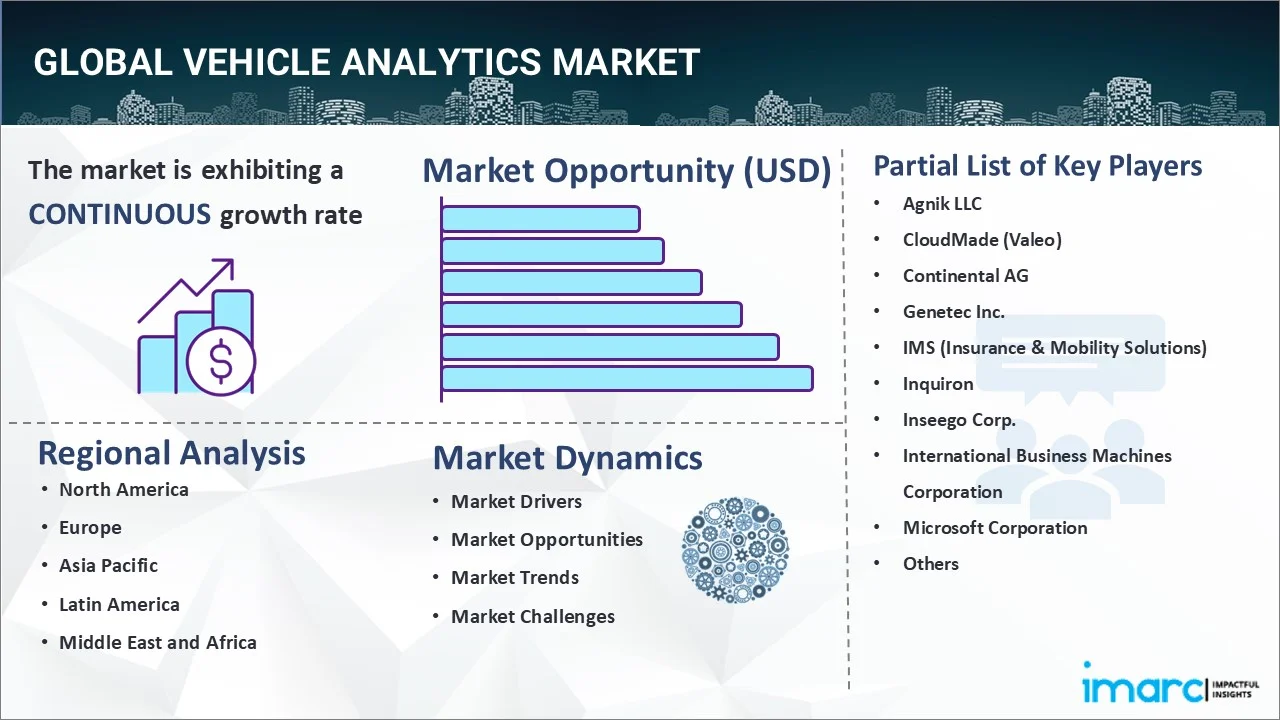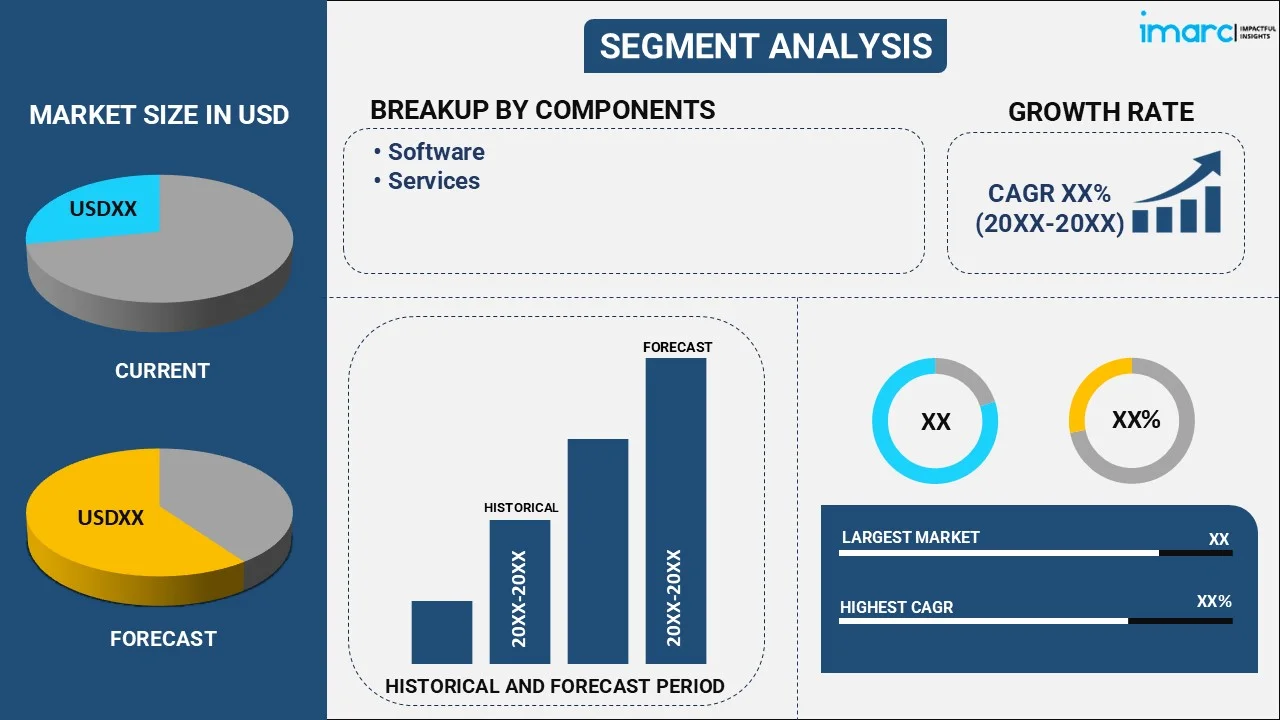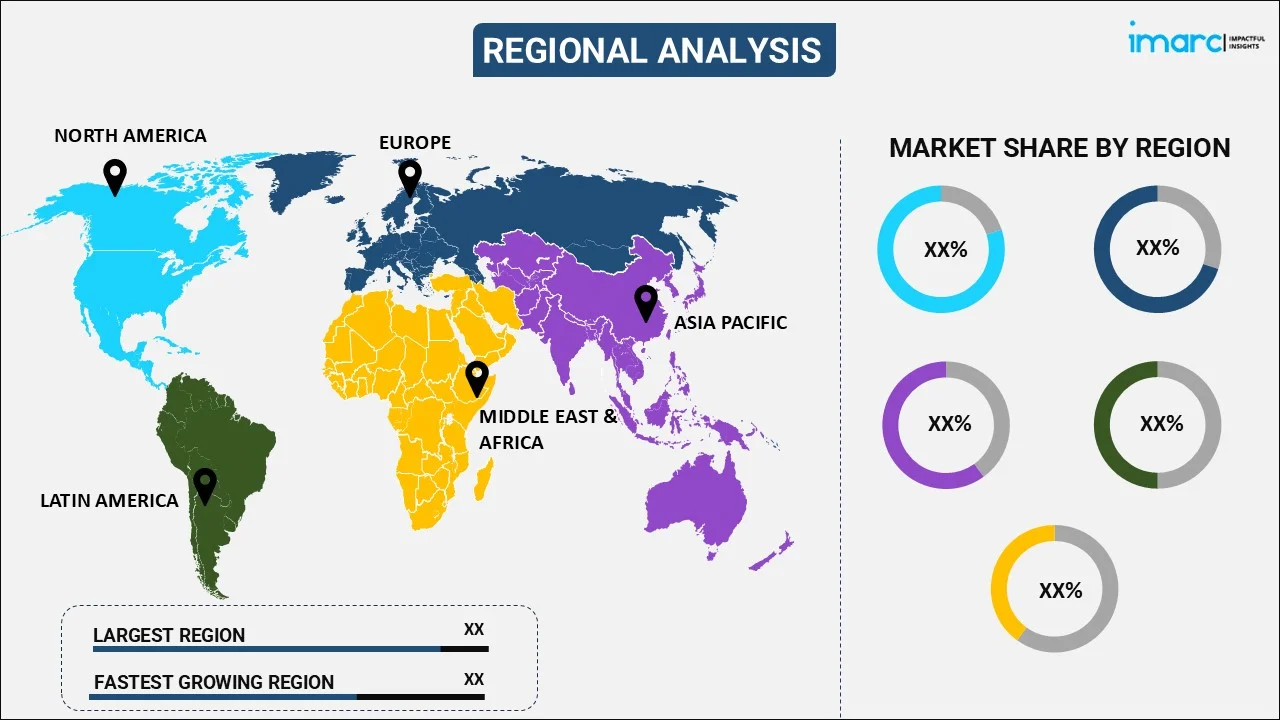
Vehicle Analytics Market Report by Component (Software, Services), Deployment Mode (On-premises, Cloud-based), Application (Dealer Performance Analysis, Driver and User Behaviour Analysis, Predictive Maintenance, Safety and Security Management, Traffic Management, Usage-based Insurance), End User (Original Equipment Manufacturers (OEMs), Insurers, Automotive Dealers, Regulatory Bodies, Fleet Owners), and Region 2025-2033
Vehicle Analytics Market Overview:
The global vehicle analytics market size reached USD 3.5 Billion in 2024. Looking forward, IMARC Group expects the market to reach USD 18.6 Billion by 2033, exhibiting a growth rate (CAGR) of 20.3% during 2025-2033. The market expansion is driven by the growing need to reduce congestion, optimize traffic signals, and improve overall transportation efficiency, increasing number of heavy-duty vehicles (HDVs), and rising demand for personalized driving tips and insights among vehicle owners.
|
Report Attribute
|
Key Statistics
|
|---|---|
|
Base Year
|
2024
|
|
Forecast Years
|
2025-2033
|
|
Historical Years
|
2019-2024
|
|
Market Size in 2024
|
USD 3.5 Billion |
|
Market Forecast in 2033
|
USD 18.6 Billion |
| Market Growth Rate 2025-2033 | 20.3% |
Vehicle Analytics Market Analysis:
- Major Market Drivers: There is a rise in the demand for electric vehicle (EVs), which is highly reliable on battery performance. This, along with the increasing development of smart cities worldwide, is strengthening the market growth.
- Key Market Trends: Large number of heavy-duty vehicles to transport numerous goods around the world is catalyzing the demand for vehicle analytics.
- Geographical Trends: Europe is the largest region for this market owing to the thriving automotive industry and stringent regulations.
- Key Players: Some of the major market players in the vehicle analytics industry include Agnik LLC, CloudMade (Valeo), Continental AG, Genetec Inc., IMS (Insurance & Mobility Solutions), Inquiron, Inseego Corp., International Business Machines Corporation, Microsoft Corporation, Samsung Electronics Co. Ltd., SAP SE, Teletrac Navman US Ltd (Vontier Corporation), among many others.
- Challenges and Opportunities: While the market faces challenges, such as ensuring data privacy and cybersecurity, it also encounters opportunities in harnessing the power of AI and machine learning (ML) for predictive maintenance and enhancing autonomous vehicle capabilities.

Vehicle Analytics Market Trends:
Rising Demand for Electric Vehicles (EVs)
According to an article published on the website of the International Energy Agency (IEA), there were 14 million new electric cars registrations globally in 2023. To gather data on battery temperature, charge cycles, and overall health of EVs, vehicle analytics is highly preferrable. Reliance of EVs on battery performance is catalyzing the demand for vehicle analytics as there is a need for constant monitoring for efficiency and longevity of the battery. The prediction of battery failures or degradation enables timely maintenance needs and the optimization of battery usage. It is important for manufacturers and users to have insights into energy consumption patterns, as it helps them to extend the range and efficiency of EVs. During braking events vehicle analytics can optimize the amount of energy recaptured, which can help in enhancing the efficiency of regenerative braking. People are also preferring analytics as it can provide EV owners with personalized driving tips and insights to improve their driving efficiency. The real-time information provided by analytics about the availability of charging stations make is highly valuable among EV owners.
Growing Number of Heavy-Duty Vehicles
An article published in 2024 on the website of the United Nations shows that heavy-duty vehicle (HDV) exports represent a modest 3.6% of the global automotive trade's total value. The main focus of fleet operators is to maximize efficiency and productivity. For managing large fleets of HDVs, fleet operators rely on vehicle analytics to gather the insight on fuel consumption, route optimization, and maintenance schedules. Vehicle analytics is also capable of tracking and managing the utilization of HDVs, ensuring that assets are used optimally and reducing downtime. Due to the extensive usage of HDVs, they are subject to high wear and tear. It is very important to prevent breakdowns and reduce repair costs and vehicle analytics can predict maintenance needs based on data trends. Unplanned downtime is a serious problem for HDVs, as it can be costly for logistics and transportation. Vehicle analytics play a major role in minimizing these downtimes, which is responsible for the market expansion of vehicle analytics.
Development of Smart Cities
Smart cities are highly reliable on vehicle analytics as it can help in managing traffic flow more effectively by providing real-time data on traffic conditions. Besides this, reducing congestion, optimizing traffic signals, and improving overall transportation efficiency. To avoid traffic, analytics can also suggest alternative routes based on real-time traffic data. Tracking and managing vehicle emissions can be done by vehicle analytics, which is also crucial in supporting initiatives to reduce air pollution. To fulfill the aim of smart cities of reducing their carbon footprint, vehicle analytics is highly important. As per the IMARC Group’s report, the global smart cities market is expected to reach USD 4,633.9 Billion by 2032.
Vehicle Analytics Market Segmentation:
IMARC Group provides an analysis of the key trends in each segment of the market, along with forecasts at the global, regional, and country levels for 2025-2033. Our report has categorized the market based on the component, deployment mode, application, and end user.
Breakup by Component:

- Software
- Services
The report has provided a detailed breakup and analysis of the market based on the component. This includes software and services.
Due to its capacity for processing and analyzing vast amounts of data gathered from automobiles, software is an essential component of vehicle analytics. It serves as the foundation for complex algorithms that analyze this data and reveal information about driver behavior, vehicle performance, and operational effectiveness.
Services are an essential part of vehicle analytics because they help manufacturers, fleet managers, and car owners connect data insights to practical solutions. Large volumes of data are produced by sensors, telematics, and other sources in vehicle analytics, which offer insightful information about driver behavior, vehicle performance, and operational effectiveness.
Breakup by Deployment Mode:
- On-premises
- Cloud-based
On-premises hold the largest share of the industry
A detailed breakup and analysis of the market based on the deployment mode have also been provided in the report. This includes on-premises and cloud-based. According to the report, on-premises account for the largest market share.
Data security and adherence to industry rules are significant priorities for numerous firms, particularly those in the automotive, manufacturing, and fleet management industries. In businesses where legacy systems and specific operational needs must be addressed, this flexibility is especially prized. For performance-related reasons, some businesses favor on-premises installations since they can manage and optimize computer resources locally, guaranteeing steady and dependable analytics program performance.
Breakup by Application:
- Dealer Performance Analysis
- Driver and User Behaviour Analysis
- Predictive Maintenance
- Safety and Security Management
- Traffic Management
- Usage-based Insurance
Safety and security management represents the leading market segment
The report has provided a detailed breakup and analysis of the market based on the application. This includes dealer performance analysis, driver and user behavior analysis, predictive maintenance, safety and security management, traffic management, and usage-based insurance. According to the report, safety and security management represent the largest segment.
Due to its crucial role in guaranteeing the safety of drivers and passengers as well as the protection of priceless assets, safety and security management is the most popular application in the automotive analytics market. By means of functions like vehicle monitoring and automated crash alerts, these analytics not only improve preventive safety measures but also provide prompt emergency responses.
Breakup by End User:
- Original Equipment Manufacturers (OEMs)
- Insurers
- Automotive Dealers
- Regulatory Bodies
- Fleet Owners
Original equipment manufacturers (OEMs) exhibit a clear dominance in the market
A detailed breakup and analysis of the market based on the end user have also been provided in the report. This includes original equipment manufacturers (OEMs), insurers, automotive dealers, regulatory bodies, and fleet owners. According to the report, original equipment manufacturers (OEMs) account for the largest market share.
Because of their crucial position in the automotive ecosystem, original equipment manufacturers (OEMs) make up the largest end user sector in the vehicle analytics industry. Ranging from design and manufacture to after-sales service and support, OEMs use vehicle analytics extensively throughout the vehicle lifecycle. Original equipment manufacturers (OEMs) can improve product design, streamline manufacturing procedures, and guarantee adherence to industry standards and regulations by using analytics to gain critical insights regarding vehicle performance, quality control, and customer usage patterns.
Breakup by Region:

- North America
- United States
- Canada
- Asia-Pacific
- China
- Japan
- India
- South Korea
- Australia
- Indonesia
- Others
- Europe
- Germany
- France
- United Kingdom
- Italy
- Spain
- Russia
- Others
- Latin America
- Brazil
- Mexico
- Others
- Middle East and Africa
Europe leads the market, accounting for the largest vehicle analytics market share
The report has also provided a comprehensive analysis of all the major regional markets, which include North America (the United States and Canada); Asia Pacific (China, Japan, India, South Korea, Australia, Indonesia, and others); Europe (Germany, France, the United Kingdom, Italy, Spain, Russia, and others); Latin America (Brazil, Mexico, and others); and the Middle East and Africa. According to the report, Europe represents the largest regional market for vehicle analytics.
Automakers in Europe want to follow stringent regulations, and for this, they use advanced analytics to meet emissions regulations, which also make their vehicle safer while boosting productivity. Moreover, the acceptance of vehicle analytics for improving production procedures, vehicle performance, and customer experience is being driven by Europe's well-established automotive sector, which places a heavy emphasis on innovation and technology integration. As per an article published in 2024 on the website of the Association of European Automobile Manufacturers (ACEA), EU new car sales surged by almost 14%, accounting for 10.5 million units in 2023.
Competitive Landscape:
- The market research report has also provided a comprehensive analysis of the competitive landscape in the market. Detailed profiles of all major companies have also been provided. Some of the major market players in the vehicle analytics industry include Agnik LLC, CloudMade (Valeo), Continental AG, Genetec Inc., IMS (Insurance & Mobility Solutions), Inquiron, Inseego Corp., International Business Machines Corporation, Microsoft Corporation, Samsung Electronics Co. Ltd., SAP SE, and Teletrac Navman US Ltd (Vontier Corporation).
(Please note that this is only a partial list of the key players, and the complete list is provided in the report.)
- Top-tier companies are channeling funds into cutting-edge data analytics technologies like AI and machine learning to mine actionable insights from the immense data generated by vehicles. This investment allows them to provide predictive maintenance, real-time diagnostics, and tailored driver behavior analysis. Leading companies are merging vehicle analytics with advanced smart technologies, including IoT, telematics, and connected car platforms. This fusion facilitates smooth data exchange and delivers holistic insights into various facets of vehicle operation and management. Numerous industry leaders are expanding their service offerings to encompass end-to-end solutions spanning the entire vehicle lifecycle from design and manufacturing to after-sales services. These comprehensive services include fleet management, remote monitoring, and cybersecurity solutions to tackle the evolving challenges in connected vehicles. Besides this, key players are focusing on initiating autonomous-drive mobility services, which needs vehicle analytics. For instance, in 2024, Nissan planned to expand functionality and commence autonomous-drive mobility services in Japan by 2027 after collaborating with local authorities and transportation operators.
Vehicle Analytics Market News:
- In 2023: Ford established Latitude AI to develop future automated driving technology and add a leading team of machine learning (ML), robotics, software, sensors, systems engineering and operations talent.
- In 2023: Dassault Systèmes announced that Renault Group is leveraging the data science capabilities of Dassault Systèmes’ 3DEXPERIENCE platform to understand the increase of raw material prices.
Vehicle Analytics Market Report Scope:
| Report Features | Details |
|---|---|
| Base Year of the Analysis | 2024 |
| Historical Period | 2019-2024 |
| Forecast Period | 2025-2033 |
| Units | Billion USD |
| Scope of the Report | Exploration of Historical Trends and Market Outlook, Industry Catalysts and Challenges, Segment-Wise Historical and Future Market Assessment:
|
| Components Covered | Software, Services |
| Deployment Modes Covered | On-Premises, Cloud-Based |
| Applications Covered | Dealer Performance Analysis, Driver and User Behavior Analysis, Predictive Maintenance, Safety and Security Management, Traffic Management, Usage-Based Insurance |
| End Users Covered | Original Equipment Manufacturers (OEMs), Insurers, Automotive Dealers, Regulatory Bodies, Fleet Owners |
| Regions Covered | Asia Pacific, Europe, North America, Latin America, Middle East and Africa |
| Countries Covered | United States, Canada, Germany, France, United Kingdom, Italy, Spain, Russia, China, Japan, India, South Korea, Australia, Indonesia, Brazil, Mexico |
| Companies Covered | Agnik LLC, CloudMade (Valeo), Continental AG, Genetec Inc., IMS (Insurance & Mobility Solutions), Inquiron, Inseego Corp., International Business Machines Corporation, Microsoft Corporation, Samsung Electronics Co. Ltd., SAP SE, Teletrac Navman US Ltd (Vontier Corporation), etc. |
| Customization Scope | 10% Free Customization |
| Post-Sale Analyst Support | 10-12 Weeks |
| Delivery Format | PDF and Excel through Email (We can also provide the editable version of the report in PPT/Word format on special request) |
Key Benefits for Stakeholders:
- IMARC’s industry report offers a comprehensive quantitative analysis of various market segments, historical and current market trends, vehicle analytics market forecasts, and dynamics of the market from 2019-2033.
- The research report provides the latest information on the market drivers, challenges, and opportunities in the global market.
- The study maps the leading, as well as the fastest-growing, regional markets. It further enables stakeholders to identify the key country-level markets within each region.
- Porter's five forces analysis assists stakeholders in assessing the impact of new entrants, competitive rivalry, supplier power, buyer power, and the threat of substitution. It helps stakeholders to analyze the level of competition within the vehicle analytics industry and its attractiveness.
- The competitive landscape allows stakeholders to understand their competitive environment and provides insight into the current positions of key players in the market.
Key Questions Answered in This Report
The global vehicle analytics market was valued USD 3.5 Billion in 2024.
We expect the global vehicle analytics market to exhibit a CAGR of 20.3% during 2025-2033.
The sudden outbreak of the COVID-19 pandemic had led to the implementation of stringent lockdown regulations across several nations resulting in the temporary halt in numerous installation activities for vehicle analytics solutions, thereby negatively impacting the global market for vehicle analytics.
The rising demand for vehicle analytics to improve the efficiency and safety of the overall driver experience by delivering detailed information regarding speed, distance, emissions, resource usage, etc., is primarily driving the global vehicle analytics market.
Based on the deployment mode, the global vehicle analytics market can be segmented into on-premises and cloud-based. Currently, on-premises hold the majority of the total market share.
Based on the application, the global vehicle analytics market has been categorized into dealer performance analysis, driver and user behavior analysis, predictive maintenance, safety and security management, traffic management, and usage-based insurance. Among these, safety and security management currently exhibits a clear dominance in the market.
Based on the end user, the global vehicle analytics market can be divided into Original Equipment Manufacturers (OEMs), insurers, automotive dealers, regulatory bodies, and fleet owners. Currently, original equipment manufacturers (OEMs) account for the largest market share.
On a regional level, the market has been classified into North America, Asia-Pacific, Europe, Latin America, and Middle East and Africa, where Europe currently dominates the global market.
Some of the major players in the global vehicle analytics market include Agnik LLC, CloudMade (Valeo), Continental AG, Genetec Inc., IMS (Insurance & Mobility Solutions), Inquiron, Inseego Corp., International Business Machines Corporation, Microsoft Corporation, Samsung Electronics Co. Ltd., SAP SE, and Teletrac Navman US Ltd (Vontier Corporation).
The future of the vehicle analytics market is promising, with significant growth expected, driven by factors including the adoption of advanced analytics techniques and the rising demand for data-driven insights in the automotive industry.
Need more help?
- Speak to our experienced analysts for insights on the current market scenarios.
- Include additional segments and countries to customize the report as per your requirement.
- Gain an unparalleled competitive advantage in your domain by understanding how to utilize the report and positively impacting your operations and revenue.
- For further assistance, please connect with our analysts.
 Inquire Before Buying
Inquire Before Buying
 Speak to an Analyst
Speak to an Analyst
 Request Brochure
Request Brochure
 Request Customization
Request Customization




.webp)




.webp)












